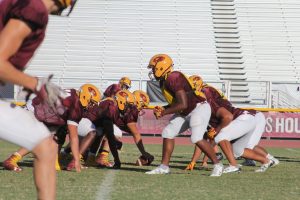- Slug: Sports-CTE Study Under 30, 780 words.
- Photo available (thumbnail, caption below).
By Jordy Fee-Platt
Cronkite News
PHOENIX – Head injuries have been a part of sports for decades. However, with every passing year, player safety is put further into question as the alarming damage from collisions becomes more clear. In 2022, a series of head injuries suffered by Dolphins quarterback Tua Tagovailoa highlighted a disturbing year in the NFL, where concussions were up 18% from 2021. This upward trend comes despite measures in recent years to protect players.
The reality looks even more grim following a recent study published by the Boston University CTE Center. Among 152 brains of contact sports athletes who died before reaching 30 years old, over 41% were diagnosed with some form of CTE.
A major concern among neuroscientists is the impact that head injuries can have on youth development. Amateurs, or those playing at a non-professional level, made up the vast majority of brains studied (84.2%), and the rate of CTE numbers was significantly worse among that age group. Of the 63 former athletes diagnosed with CTE, 45 (71.4%) were amateurs.
Diego Mastroeni, an Associate Research Professor at Arizona State’s Neurodegenerative Disease Research Center, says the outlook for teenage brain development is concerning.
“There are long-term consequences that people aren’t really considering as much, and what we’re finding in the studies that we’ve done is there is a significant increased risk for neurodegenerative diseases as well as Alzheimer’s for example, other types of dementia, even Parkinson’s,” Mastroeni said.
In Arizona, parents are showing their concern, and it is dramatically impacting participation in contact sports, particularly football. In 2016, 68% of parents were willing to let their children play on the gridiron, according to Phoenix’s Barrow Neurological Institute. Four years later, that number dropped to 47%. With new information constantly emerging, that number is likely to decline further.
Researchers have found that the worst damage to brains comes from repeated blows to the head, rather than one large collision. Athletes will often fail to notice the smaller hits.
“Most of those you don’t really feel,” Mastroeni said. “And you go back out on the field or pitch and it’s those repetitive hits that are actually more deleterious than those with a single blow. When we get those single blow hits, it forces us to come out of the game and forces us to come back to baseline before we play again. It forces us to rest and let our brain heal.”
For Mastroeni, who played high school sports, head injuries have hit very close to home. His brother Pablo Mastroeni played for 12 years in the MLS as a midfielder, making 225 appearances for the Colorado Rapids and earning 65 caps for the U.S. men’s national team. He’s currently the head coach of Real Salt Lake.
Near the end of his playing career in 2012 and 2013, Pablo suffered two concussions in a span of six months. It affected him deeply, as he dealt with insomnia and frequent headaches following the injuries. After the first concussion in late 2012, a note from a young fan prompted him to wear headgear entering 2013, looking for improved protection.
“It’s something that needs to be taken seriously, and anything that can help with any type of hard impact and alleviate some of that, is useful,” Pablo said in 2013. “It’s not just for me, but for everyone else out there who has struggled with these symptoms.”
Head injuries in soccer are increasingly common. In the Boston University study, over 17% of soccer players were found to have CTE. This included a female soccer player being diagnosed with the condition, a rare occurrence at this point.
With the sport growing in the U.S., Diego expects to not only see more CTE cases in soccer but also believes more women will be diagnosed with the disease.
“We see that soccer is really exploded,” Diego said. “I think that women in fact might be even more at risk for trauma than men, and that’s just based on basic biology. The structure of the skull is a little bit thicker in men than it is in women.”
As someone who loved playing sports, Diego has trouble grappling with the potential downsides. Especially in football, many players come from underrepresented backgrounds, and sports often represent a way to pursue a better life.
“Sometimes these sports are their only way out of the community,” Diego said. “You talk about sacrifice, I mean you’re willing to do whatever it takes.”
The most important thing, he says, is that everyone has information about head injuries available to them. Decisions from there are up to each individual family.
“I think knowledge is power in this world,” Diego said. “As long as everyone has the same information, and they make the decision that they’re allowing this to happen, it’s hard for me to say it’s wrong.”
For more stories from Cronkite News, visit cronkitenews.azpbs.org.
